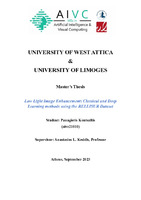Low light image enhancement: Classical and deep learning methods using the RELLISUR dataset
Ενίσχυση σκοτεινών εικόνων: Κλασικές μέθοδοι και μέθοδοι βαθιάς μάθησης με χρήση του συνόλου δεδομένων RELLISUR

Μεταπτυχιακή διπλωματική εργασία
Συγγραφέας
Κουτσαύτης, Παναγιώτης
Ημερομηνία
2023-09-14Επιβλέπων
Kesidis, AnastasiosΛέξεις-κλειδιά
Επεξεργασία εικόνας ; Ενίσχυση σκοτεινών εικόνων ; Βαθιά μάθησηΠερίληψη
It is well known that digital images are used every day in many fields, which include medicine, agriculture and law enforcement. The systems used in the above fields require the input images to be of high quality without noise. However, there are many factors that can reduce the quality of an image. One of them is low light conditions, e.g when the image is taken at night time and/or indoors. Due to these conditions, the light reflected from the scene and reaching the sensor is very weak resulting in final images characterized by low contrast and brightness, with pixel values concentrated in the left part of the histogram, which introduces noise and color distortions. Such images must be enhanced before being used in vision systems. The purpose of this work is the study and application of such image processing methods, that are known as Low Light Image Enhancement (LLIE) methods, and aim to enhance dark images without introducing additional noise. Initially, a variety of learning free algorithms are studied, which apply a mathematical operation to each image. Then, in an attempt to improve the results, machine learning methods are involved, specifically deep learning models, which use information from the available data set, to learn the representation between the dark and ground truth images. For this purpose, two variations of a Convolutional Neural Network architecture are proposed. All the methods are applied to the RELLISUR dataset, which includes truly dark images, rather than images produced by applying a transformation to the ground truth images, and is divided into different darkness levels. The results of the methods are evaluated by metrics that either use a reference image or not. This evaluation led to the conclusion that classical methods, although they give satisfactory results, show weakness in excessively dark images, introducing additional noise and color distortions. On the other hand, the deep learning methods that were applied, and especially the two proposed variations, produced more accurate visual results where the experimental images are characterized by high contrast and brightness.
Αριθμός σελίδων
515Σχολή
Σχολή ΜηχανικώνΑκαδημαϊκό Τμήμα
Τμήμα Μηχανικών Πληροφορικής και ΥπολογιστώνΤμήμα Μηχανικών Τοπογραφίας και Γεωπληροφορικής

